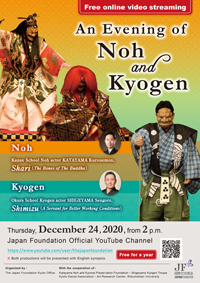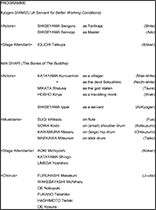An Evening of Noh and Kyogen 2020
(Free online video streaming)※Distribution closed on Friday, December 24, 2021 at 2:00 p.m..
Every year in autumn, the Japan Foundation Kyoto Office organizes an event called “An Evening of Noh and Kyogen” to give people an opportunity to experience traditional Japanese culture, inviting international students, the Japan Foundation Fellows, and those enrolled at the Japanese-Language Institute, Kansai to join us. This year, however, the outbreak of COVID-19 has resulted in travel restrictions, making it difficult for students and Japanese Studies scholars abroad to come to Japan. To minimize the risk of virus transmission, we will take a new approach to this year’s event. Performances will be filmed without an audience and released for online video streaming, which will be made available to the public free of charge for one year.
| Date and time |
Thursday, December 24, 2020, from 2:00 p.m. *Free for one year |
|---|---|
| Program | <Kyogen> Shimizu (A Servant for Better Working Conditions) Featuring: SHIGEYAMA Sengoro <Noh> Shari (The Bones of The Buddha) Featuring: KATAYAMA Kurouemon (Both productions will be presented with English subtitles giving a synopsis of the plot.) |
| Presented by | The Japan Foundation Kyoto Office |
| In cooperation with | Katayama Noh and Kyomai Preservation Foundation Shigeyama Kyogen Troupe Kyoto Kanze Association Art Research Center, Ritsumeikan University |
| Contact: | The Japan Foundation Kyoto Office Tel: 075-762-1136 |
Programme Synopsis
Kyogen: Shimizu (A Servant for Better Working Conditions)
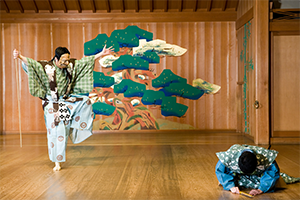
Synopsis
A master has decided to invite people over for tea. He orders his servant, Tarokaja, to go to the spring in the field known as “Nonaka no Shimizu” and to draw some pure water needed for the tea ceremony, handing his treasured wooden bucket to him. Tarokaja, afraid of making it a habit for the master to ask him to go fetch the water, returns home without the wooden bucket, making up a story about a demon that appeared at the spring. The master, insisting that the bucket was his most treasured item, decides that he will go to the spring to retrieve it. Wondering what to do, Tarokaja hurries to the spring and awaits his master. Upon the master’s arrival, Tarokaja puts on a demon mask, striking a menacing pose to frighten the master. Horrified, the master runs away and comes home. As the master recounts the incident to Tarokaja, he comes to realize that the demon and Tarokaja are one and the same. The master goes to the spring to look for his bucket again. Tarokaja attempts to stop the master, but the master pushes Tarokaja away and sets out. Tarokaja has no choice but to go to the spring once again.
<Kyogen>
Kyogen is a form of comic theater that emerged during Japan’s Muromachi period (around 1336 to 1573) and developed alongside Noh. It traces its origins to “Sarugaku,” a form of Japanese entertainment dating back to the late Heian period (mid-12th century). Later, the term “Nohgaku” was created to encompass these twin arts of Noh and Kyogen. While Noh is a tragic musical play, Kyogen is a comedy based on spoken dialog and wordplay. Performed as an interlude between acts of the more solemn Noh play, Kyogen creates comic relief, inducing laughter from the audience like a circus clown.
Stories of blunders in everyday life or making fun of the little quarrels among couples are the favorite motifs of Kyogen, a laughter theme unchanging even in modern days. Kyogen is a universal form of art that has made people laugh for centuries and will for centuries to come.
Noh: Shari (The Bones of The Buddha)
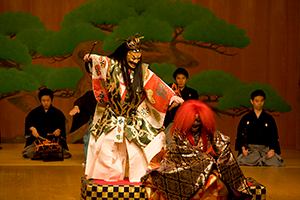
Synopsis
As Indian legend has it, when the Buddha passed away in India, a fleet-footed demon called Sokushikki snatched the Buddha’s teeth (called geshari) from his remains and ran off with them. This demon, however, was immediately chased by an even faster divinity called Idaten, who quickly caught him and recovered the relic.
Sennyuji is a Buddhist temple in Higashiyama, Kyoto. A reliquary hall stands there enshrining the Buddha’s teeth, which were recovered by Idaten in India. The temple is a sanctuary for Buddhists searching for spiritual guidance. One day, a travelling monk stops at the temple to worship the relic. Then a man appears and joins the monk in prayer. Suddenly, there is a thunderclap, and the man, having snatched the relic, runs off with it. The man turns out to be the demon Sokushikki.
In answer to a temple servant’s prayer, the guardian deity Idaten appears and finds Sokushikki as he is escaping through the heavens. Finally, the deity hunts down the demon and sends him down to the earth. When Idaten retrieves the relic, Sokushikki vanishes.
<Noh>
Noh traces its origins as far back as the 14th century, and it has continued to this day, uninterrupted. Noh was originally a form of entertainment for the common people, as a rite performed to pray for bountiful harvests and good fortune. It later began to draw its plots from works of classical literature, giving the audience a greater appreciation for the literary depth of the world. Its themes include gods’ blessings, prayers for the dead, manifestation of beauty, and states of emotional unrest in the face of a crisis. These themes are universal, and hence Noh has continued to be appreciated. In this particular Noh play Shari, the story unfolds at a rapid pace, making the Buddhist tale accessible and enjoyable to all.
The methods of expression in Noh have been refined over hundreds of years, and are distilled down to a bare minimum, evoking the audience’s imagination and inviting them to actively infer the significance of each move for themselves. Masks, costumes, music, and movements embody the essential features of Japanese culture. Join us, and we will guide you through the world of Noh to invite you to experience the essence of Japanese culture.
Profile
SHIGEYAMA Sengoro
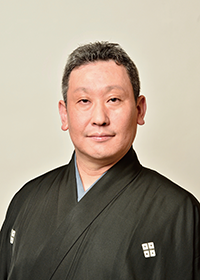
Born in 1972. Eldest son of Shigeyama Sensaku V. Birth name Masakuni.
First appeared on stage at the age of four as the protagonist of “Iroha.” Subsequently led such projects as the Hanagata Kyogen Kai, the Kyogen Shogekijo, “TOPPA!,” and the Kokoromi no Kai in his efforts to win new fans not just for Kyogen but also for Noh theater itself. Currently, he is working to communicate the appeal of Kyogen to a wider age-range of audiences by leading such projects as the Shigeyama Kyogen Kai, the “Cutting Edge KYOGEN” group (a revamped Hanagata Kyogen Kai), the Kashizuki no Kai in partnership with his younger brother, Shigeru, and the Waraenai Kai in partnership with Rakugo specialist Katsura Yonekichi. He has also actively collaborated with artists in other theatrical genres, including Yan Qinggu of the Shanghai Jingju Theatre Company and the Sichuan opera face changing master Jiang Peng. Succeeded to Shigeyama Sengoro XIV in 2016. Recipient of the Agency for Cultural Affairs’ New Artist Award of the National Arts Festival in 2005, recipient of Kyoto Prefectural Culture Award’s Distinguished Service Prize in 2008.
KATAYAMA Kurouemon
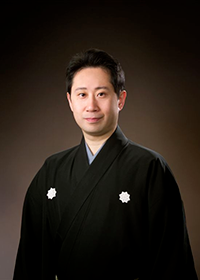
A shite (primary actor) of the Kanze School of Noh, Katayama Kurouemon was born in 1964 in Kyoto as the first son of Katayama Yusetsu (Katayama Kurouemon IX). His grandmother was the late Inoue Yachiyo IV, the former head of the Inoue School of the traditional Kyoto Kyomai dance, and his older sister is Inoue Yachiyo V, the head of the Inoue School.
He studied Noh under his father and then Kanze Tetsunojo VIII. He organizes the Katayama Regular Noh performances. He performs frequently in theaters throughout the country, and often joins overseas tours to Europe, the United States, and other countries as well.
He is involved in a variety of activities which are designed to share the joy of Noh with younger generations, including visiting Noh classes at schools, production of Noh picture books, and the creation of virtual Noh plays using computer graphics technology.
He is a recipient of the Kyoto Prefectural Cultural Encouragement Award, the Kyoto Municipal New Artist Award, the New Artist Award of the National Arts Festival of the Agency for Cultural Affairs, the Japan Traditional Cultures Foundation Award, the Kyoto Prefectural Culture Award’s Distinguished Service Prize, and the Minister of Education, Culture, Sports, Science and Technology’s Art Encouragement Prize for New Artists.
He is a holder of Important Intangible Cultural Properties (collective recognition) and also serves as director of the Kyoto Kanze Kai association and President of the Katayama Noh and Kyomai Preservation Foundation.
[Contact Us]
The Japan Foundation Kyoto Office
(3rd Floor, Kyoto International Community House 2-1 Torii-cho, Awataguchi, Sakyo-ku, Kyoto)
Tel: +81-(0)75-762-1136
- About Us Top
- About the Japan Foundation
- Donations
- News & Topics
- News & Topics Top
- Main Activities
- Main Activities Top
- Fiscal Year 2025-2026
- Fiscal Year 2024-2025
- Fiscal Year 2023-2024
- Fiscal Year 2022-2023
- Fiscal Year 2021-2022
- Fiscal Year 2020-2021
- Fiscal Year 2019-2020
- Fiscal Year 2018-2019
- Fiscal Year 2017-2018
- Fiscal Year 2016-2017
- Fiscal Year 2015-2016
- Fiscal Year 2014-2015
- Fiscal Year 2013-2014
- Events / Projects
- Press Release
- Press Release Top
- Fiscal Year 2025-2026
- Fiscal Year 2024-2025
- Fiscal Year 2023-2024
- Fiscal Year 2022-2023
- Fiscal Year 2021-2022
- Fiscal Year 2020-2021
- Fiscal Year 2019-2020
- Fiscal Year 2018-2019
- Fiscal Year 2017-2018
- Fiscal Year 2016-2017
- Fiscal Year 2015-2016
- Fiscal Year 2014-2015
- Fiscal Year 2013-2014
- Links

